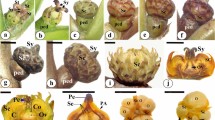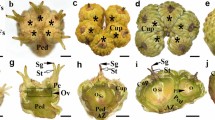Abstract
For a better understanding of pollen-tube guidance in relation to pollen-pistil interaction, we investigated the mode of pollen-tube growth in pistils of Casuarina equisetifolia, a monoecious, wind-pollinated species that undergoes chalazogamous fertilization. The pistil is bicarpellate, but only one of the two carpels develops with two ovules. One of these ovules develops more than four embryo sacs. Pistils usually require more than 1 month to reach maturity after pollen grains have been deposited on the stigmas. During that period, pollen-tube growth proceeds discontinuously in five distinct steps that lead up to fertilization: (1) from the stigma to the upper region of the style, (2) from the upper region of the style to a septum in the ovary, (3) from the septum to the surface of the funiculus, (4) from the funiculus to chalaza in the ovule, and (5) from the chalaza to an egg apparatus. Probably because of competitive interaction between male and female gametophytes (or ovules), one pollen tube is selected from among many during the first step (just before the second step), one ovule from the two during the second and third steps, and one embryo sac from more than four during the fourth and fifth steps. On the basis of our results, erroneous drawings and explanations reported in earlier publications on chalazogamy in Casuarinaceae should be brought into question.






Similar content being viewed by others
References
Barlow BA (1958) Heteroploid twins and apomixis in Casuarina nana. Aust J Bot 6:204-219
Benson M (1894) Contribution to the embryology of the Amentiferae.- Part I. Trans Linn Soc London Bot 3:409–424
Boavida LC, Varela MC, Feijo JA (1999) Sexual reproduction in the cork oak (Quercus suber L.). I. The progamic phase. Sex Plant Reprod 11:347–353
Cecich RA (1997) Pollen tube growth in Quercus. For Sci 43:140–146
Coimbra S, Salema R (1999) Ultrastructure of the developing and fertilized embryo sac of Amaranthus hypochondriacus L. Ann Bot 84:781–789
Copeland HC (1955) The reproductive structures of Pistacia chinensis (Anacardiaceae). Phytomorphology 6:440–449
Dahl ÅE, Fredrikson M (1996) The timetable for development of maternal tissues sets the stage for male genomic selection in Betula pendula (Betulaceae). Am J Bot 83:895–902
Derksen J, Rutten T, van Amstel T, De Win A, Doris F, Steer M (1995) Regulation of pollen tube growth. Acta Bot Neerl 44:93–119
Faure J-E, Rotman N, Fortuné P, Dumas C (2002) Fertilization in Arabidopsis thaliana wild type: developmental stages and time course. Plant J 30:481–488
Frye TC (1903) The embryo sac of Casuarina stricta. Bot Gaz 36:101–113
Gao X, Francis D, Ormrod JC, Bennett MD (1992) An electron microscopic study of double fertilization in allohexaploid wheat Triticum aestivum L. Ann Bot 70:561-568
Germain E (1994) The reproduction of hazelnut (Corylus avellana L.): a review. Acta Hortic 351:195–203
Grundwag M (1976) Embryology and fruit development of four species of Pistacia L. (Anacardiaceae). Bot J Linn Soc 73:353–370
Herr JM (1971) A new clearing-squash technique for the study of ovule development in angiosperms. Am J Bot 58:785–790
Herrero M, Arbeloa A (1989) Influence of the pistil on pollen tube kinetics in peach (Prunus persica). Am J Bot 76:1441–1447
Higashiyama T (2002) The synergid cell: attractor and acceptor of the pollen tube for double fertilization. J Plant Res 115:149–160
Higashiyama T, Kuroiwa H, Kawano S, Kuroiwa T (1998) Guidance in vitro of the pollen tube to the naked embryo sac of Torenia fournieri. Plant Cell 10:2019–2031
Higashiyama T, Yabe S, Sasaki N, Nishimura Y, Miyagishima S, Kuroiwa H, Kuroiwa. T (2001) Pollen tube attraction by the synergid cell. Science 293:1480–1483
Huang B-Q, Strout GW, Russell SD (1993) Fertilization in Nicotiana tabacum: ultrastructual organization of propane-jet-frozen embryo sacs in vivo. Planta 191:256–264
Hülskamp M, Schneitz K, Pruitt RE (1995) Genetic evidence for a long-range activity that directs pollen tube guidance in Arabidopsis. Plant Cell 7:57–64
Johnson LAS, Wilson KL (1989) Casuarinaceae: a synopsis. In: Crane PR, Blackmore S (eds) Evolution, systematics, and fossil history of the Hamamelidae, vol 2. Clarendon Press, Oxford, pp 167–188
Johnson LAS, Wilson KL (1993) Casuarinaceae. In: Kubitzki K, Rohwer JG, Bittrich V (eds) The Families and genera of vascular plants, vol 2. Springer, Berlin Heidelberg New York, pp 152–157
Johnson MA, Preuss D (2002) Plotting a course: multiple signals guide pollen tubes to their targets. Dev Cell 2:273–281
Johri BM, Ambegaokar KB, Srivastava PS (1992) Comparative embryology of angiosperms. Springer, Berlin Heidelberg New York, pp 143–115
Karsten G (1902) Über die Entwicklung der weiblichen Blüthen bei einigen Juglandaceen. Flora 90:316–333
Kristóf Z, Tímár O, Imre K (1999) Changes of calcium distribution in ovules of Torenia fournieri during pollination and fertilization. Protoplasma 208:149–155
Kuroiwa H (1989) Ultrastructual examination of embryogenesis in Crepis capillaris (L.) Wallr.: 1. The synergid before and after pollination. Bot Mag 102:9-24
Langdon LM (1934) Embryogeny of Carya and Juglans, a comparative study. Bot Gaz 96:93–117
Luza JG, Polito VS (1991) Porogamy and chalazogamy in walnut (Juglans regia L.). Bot Gaz 152:100–106
Maheshwari P (1950) An introduction to the embryology of angiosperms. McGraw-Hill, New York
Martin FW (1958) Staining and observing pollen tubes in the style by means of fluorescence. Stain Technol 33:125–128
Martínez-Pallé E, Herrero M (1998) Pollen tube pathway in chlazogamous Pistacia vera L. Int J Plant Sci 159:566–574
Nast CG (1935) Morphological development of the fruit of Juglans regia. Hilgardia 9:345–381
Nast CG (1941) The embryology and seedling morphology of Juglans regia L. Lilloa 6:163–205
Nawaschin S (1895) Neue Ergebnisse über die Embryologie der Hasel (Corylus Avellana). Bot Centralbl 63:353–357
Ray S, Park SS, Ray A (1997) Pollen tube guidance by the female gametophyte. Development 124:2489–2498
Russell SD (1992) Double fertilization. Int Rev Cytol 140:357–388
Russell SD (1996) Attraction and transport of male gametes for fertilization. Sex Plant Reprod 9:337–342
Shimizu KK, Okada K (2000) Attractive and repulsive interactions between female and male gametophytes in Arabidopsis pollen tube guidance. Development 127:4511–4518
Shuraki YD, Sedgley M (1997) Pollen pathway and stimulation of embryo sac development in Pistacia vera (Anacardiaceae). Ann Bot 79:361–369
Stairs GR (1964) Microsporogensis and embryogenesis in Quercus. Bot Gaz 125: 115–121
Swamy BGL (1948) A contribution to the life history of Casuarina. Proc Am Acad Arts 77:1-32
Tian H-Q, Russell SD (1997) Calcium distribution in fertilized and unfertilized ovules and embryo sacs of Nicotiana tabacum L. Planta 202:93–105
Treub M (1891) Sur les Casuarinées et leur place dans le système naturel. Ann Jard Bot Buitenzorg 10:145–231
Van Went JL, Willemse MTM (1984) Fertilization. In: Johri BM, (eds) Embryology of angiosperms. Springer, Berlin Heidelberg New York, pp 273–317
Ye X-L, Yeung EC, Zee S-Y (2002) Sperm movement during double fertilization of a flowering plant, Phaius tankervilliae. Planta 215:60–66
Acknowledgments
The authors are grateful to Fumiyoshi Ishidate (Carl Zeiss) for technical advice on the multi-photon laser-scanning microscope, and to Hiroaki Setoguchi, Toru Tokuoka, Yukitoshi Kimoto, Jung Sung Kim, Masumi Kono, Tomoki Kadokawa and Kentaro K. Shimizu for their suggestions on completing the manuscript. The study was supported by a Grant-in-Aid for Scientific Research from the Japan Society for the Promotion of Science (No. 14405012) and funds from Suntory Flowers Limited.
Author information
Authors and Affiliations
Corresponding author
Rights and permissions
About this article
Cite this article
Sogo, A., Noguchi, J., Jaffré, T. et al. Pollen-tube growth pattern and chalazogamy in Casuarina equisetifolia (Casuarinaceae). J Plant Res 117, 37–46 (2004). https://doi.org/10.1007/s10265-003-0129-z
Received:
Accepted:
Published:
Issue Date:
DOI: https://doi.org/10.1007/s10265-003-0129-z




